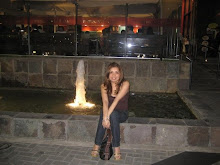The City of Cusco.- Declared a World Cultural Heritage by UNESCO in 1983.
Cuzco, which in the ancient Quechua language means "navel of the world", was an im portant hub in Inca times that connected all of South America, from Colombia to the north of Argentina. Today, centuries later, Cuzco continues to be the centre of attention, not only for our neighbouring countries but for the whole world. In its streets, historical centres, churches, pubs and cafés you can hear not only Quechua and Spanish spoken, but such diverse languages as English, French, Japanese and Hebrew. All of them, united by the same experience, found in the charming and fascinating "belly button" of the world.
portant hub in Inca times that connected all of South America, from Colombia to the north of Argentina. Today, centuries later, Cuzco continues to be the centre of attention, not only for our neighbouring countries but for the whole world. In its streets, historical centres, churches, pubs and cafés you can hear not only Quechua and Spanish spoken, but such diverse languages as English, French, Japanese and Hebrew. All of them, united by the same experience, found in the charming and fascinating "belly button" of the world.
Cuzco, which in the ancient Quechua language means "navel of the world", was an im
Machu Picchu - Inscribed by UNESCO as a World Heritage Site also in 1983.
I could say a great deal about this archaeological site, which was hidden for centuries until it came to light in the early 1900s, but it is difficult to describe in words what one feels when the citadel suddenly appears, like a challenge to the imagination and to engineering, between the mountains that mark the beginning and the end of the Andes and the Amazon Basin.
Chan Chan - Inscribed as World Cultural Heritages by UNESCO, this in 1986.
Known as the largest city of clay in pre-Columbian America, Chan Chan is texture, it is form, it is desert sand made into art. The birds that decorate the walls of Chan Chan seem almost to fly in the strong breeze that blows through this ancient Chimu site.
The Manu National Park - Inscribed as a World Natural Heritage in 1987.
Manu is the feast of life and diversity, with more than
Lima's Historical Centre - Declared a World Cultural Heritage in 1991.
Lima is a sum of colours, textures and sounds. It is a cosmopolitan capital par excellence where the taste is acquired from the flavour offered by its street-side cooks frying anticuchos or soft picarones in syrup against a backdrop of colonial balconies, old houses, and churches with secret tunnels.
excellence where the taste is acquired from the flavour offered by its street-side cooks frying anticuchos or soft picarones in syrup against a backdrop of colonial balconies, old houses, and churches with secret tunnels.
Lima is a sum of colours, textures and sounds. It is a cosmopolitan capital par
The Nazca Lines and the Pampas de Juma - Declared a World Heritage site in 1994.
Close to the other natural jewel that is the Paracas National Reserve, these lines and figures of different animals, drawn on the Peruvian desert and seen properly only from the sky, were considered a mystery for decades because it was not known if they were a calendar or a form of communication with outer space.
Close to the other natural jewel that is the Paracas National Reserve, these lines and figures of different animals, drawn on the Peruvian desert and seen properly only from the sky, were considered a mystery for decades because it was not known if they were a calendar or a form of communication with outer space.
Arequipa's Historical Centre - Declared a World Cultural Heritage in 2000.
The city of Arequipa is, precisely, an example of how culture in Peru is constantly abrew. Arequipa, known as the White City because of the volcanic rock, or "sillar", with which its churches and homes are built. Arequipa is the land of passions and contrasts, of the hot rocoto pepper and the magnificent condor which can only be seen flying over the Colca Canyon, one of the deepest in the world.
The city of Arequipa is, precisely, an example of how culture in Peru is constantly abrew. Arequipa, known as the White City because of the volcanic rock, or "sillar", with which its churches and homes are built. Arequipa is the land of passions and contrasts, of the hot rocoto pepper and the magnificent condor which can only be seen flying over the Colca Canyon, one of the deepest in the world.
